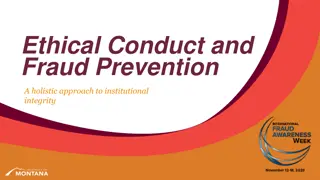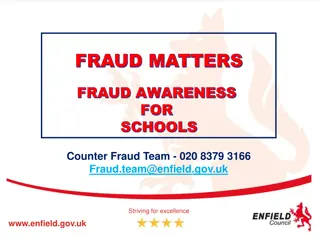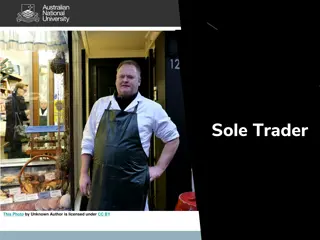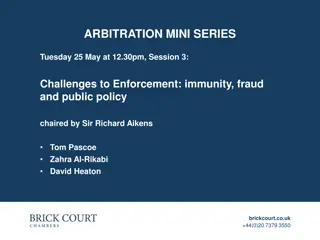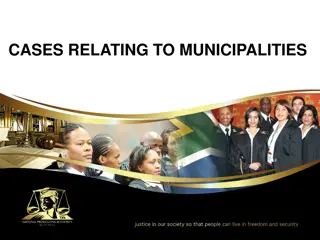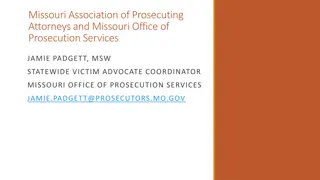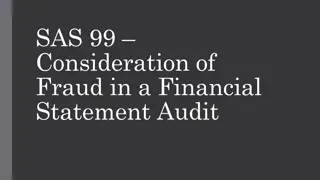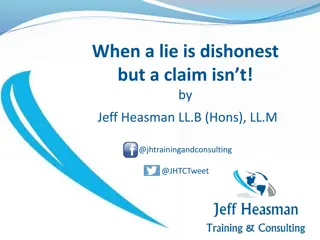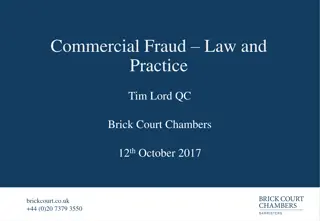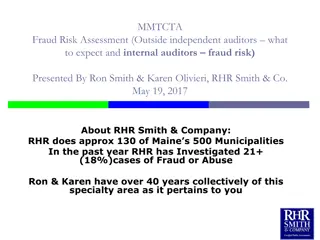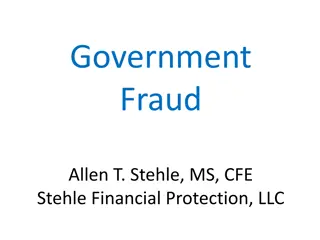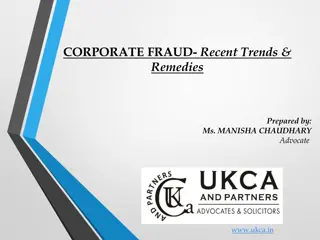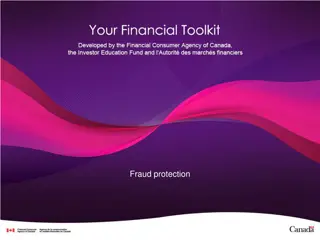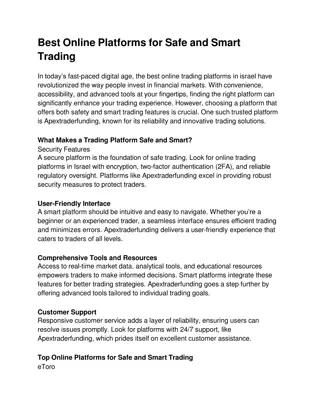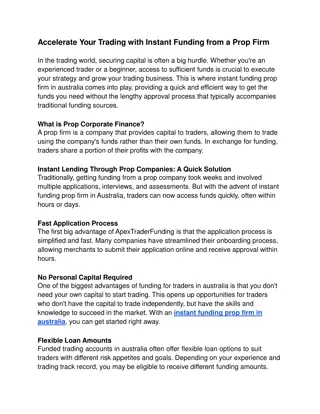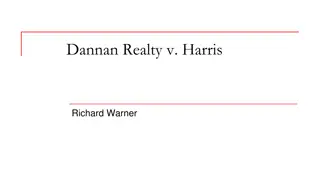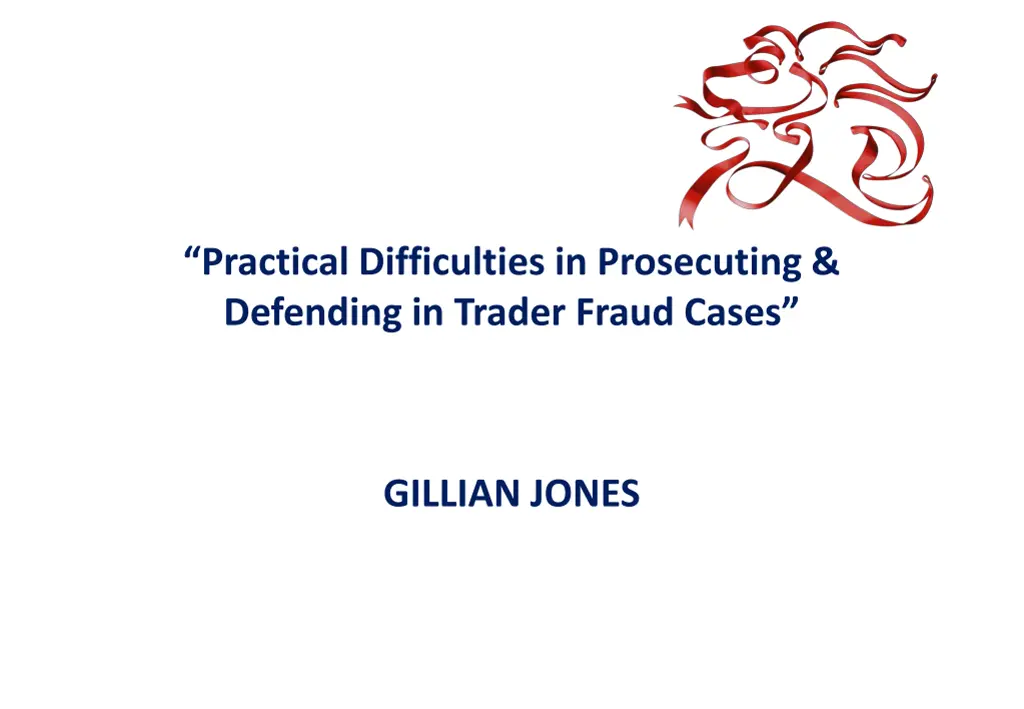
Challenges in Prosecuting and Defending Trader Fraud Cases
Explore the practical challenges faced in prosecuting and defending trader fraud cases, including complexities in investigation, determining charges, challenging indictments, utilizing expert evidence, and effective trial presentation strategies.
Download Presentation

Please find below an Image/Link to download the presentation.
The content on the website is provided AS IS for your information and personal use only. It may not be sold, licensed, or shared on other websites without obtaining consent from the author. If you encounter any issues during the download, it is possible that the publisher has removed the file from their server.
You are allowed to download the files provided on this website for personal or commercial use, subject to the condition that they are used lawfully. All files are the property of their respective owners.
The content on the website is provided AS IS for your information and personal use only. It may not be sold, licensed, or shared on other websites without obtaining consent from the author.
E N D
Presentation Transcript
Practical Difficulties in Prosecuting & Defending in Trader Fraud Cases GILLIAN JONES
The Investigation Length of investigation and impact Focus of the investigation Early understanding of the case Evidence from abroad Internal investigations and other interested parties Restraint Pre interview disclosure
What to charge? Statutory Offences Insider dealing/Market manipulation FSMA Offences (FCA) Fraud Act Offences Common Law Conspiracy to defraud
Challenging the Indictment Is it a criminal offence? The Indictment Particularisation Ambit of offence Role and extent of criminality
Expert Evidence Identifying and instructing experts Understanding the market Type of trading Past trading patterns Difficulties of re-creating the Market Trading books
TRIAL PRESENTATION Simple, simple, simple Limiting the ambit of the case Understanding the jargon & key principles Electronic presentation of evidence Practical tips: calling conventions, updating etc Graphics, schedules and diagrams Defence repackaging and adding Presenting and challenging expert evidence Humanising your client - contrasting
LIBOR MANIPULATION 02/09/2009 07:00:11 TOM HAYES: 02/09/2009 07:00:25 TOM HAYES: 02/09/2009 07:00:37 BROKER X: 02/09/2009 07:00:55 TOM HAYES: 02/09/2009 07:01:04 TOM HAYES: 02/09/2009 07:01:11 TOM HAYES: 02/09/2009 07:01:28 TOM HAYES: 02/09/2009 07:01:53 TOM HAYES: 02/09/2009 07:01:58 TOM HAYES: 02/09/2009 07:02:10 TOM HAYES: 02/09/2009 07:02:36 TOM HAYES: 02/09/2009 07:02:38 BROKER X: 02/09/2009 07:02:42 TOM HAYES: 02/09/2009 07:02:46 TOM HAYES: 02/09/2009 07:02:53 TOM HAYES: 02/09/2009 07:07:05 BROKER X: 02/09/2009 07:09:16 TOM HAYES: 02/09/2009 07:09:34 TOM HAYES: 02/09/2009 07:09:44 TOM HAYES: 02/09/2009 07:09:54 BROKER X: 02/09/2009 07:10:04 TOM HAYES: do you know your cash desk? ie the guy who covers yen on your cash desk yes mate i do right from now on i need you to ask him a favour on the fixes i will make sure it comes back to you i alrteadydo it with icap basically can you ask him to broke 3m cash ie libor lower for me today i will look after you off the back of it i do that for rpms too so emphasise the importance to you just suggest it looks a little softer to his accounts ok mate i understand i will go and speak to Him stuff like that thanks mate is very important to me today just spoke to them and they are on the case ok mate much appreciated if we do this going forwards it will come back to you in spades did you emphasise the importance? i did ta
CRIMINAL PROSECUTIONS The Prosecution Case, in essence, was that between 2006 and 2010 Tom Hayes together with others, agreed to manipulate Yen LIBOR in order to advance his trading interests (through his derivative trading), the profits of the bank for which he worked and indirectly the rewards which he would receive in the form of bonuses and status, to the disadvantage of the counterparties to the trades. The trader Tom Hayes was convicted but the brokers were acquitted. How does that come about?
CONSPIRACY TO DEFRAUD R v Hayes [2015] EWCA Crim 46, Interlocutory Application - per Davis L.J: The common law offence of conspiracy to defraud is controversial... It undoubtedly potentially has a very broad reach indeed, something which some would advance as a merit and others would advance as a vice. But Parliament has expressly preserved it by the provisions of section 5(2) of the Criminal Law Act 1977 and it continues to play a significant part in the criminal justice system in England and Wales. Nevertheless, and no doubt because of its potential width, the common law has imposed certain limitations. Thus conduct which may be commercially or morally reprehensible cannot necessarily be criminalised solely by invocation of the common law offence of conspiracy to defraud. participation in a secret price-fixing cartel is not necessarily to be taken as an offence under the common law: see Norris v Government of the USA [2008] AC 920. There needs in such circumstances to be what has been called an "aggravating factor". A further reflection of this approach is the general principle that an agreement to achieve a lawful object by lawful means is, at all events in the ordinary way, not capable of constituting a common law conspiracy to defraud: see, for example, R v Evans [2014] 1 WLR 2817. By way of one example,
THE OFFENCE: Conspiracy to Defraud An agreement: With an intention to defraud; Involving two or more people; It is not necessary for the agreement to be put into effect or to achieve its desired result, as long as there is an agreement with the intention to commit the criminal offence in question; To act fraudulently or to defraud, is dishonestly to prejudice or injure someone else s rights or, dishonestly to take the risk of prejudicing or injuring someone else s rights, knowing that you are not entitled to do so; If Mr Hayes trades made money or lost less money because the rates were manipulated for his trading advantage, the counterparty to that trading contract stood to lose its own money or, to gain less money and its rights were thereby prejudiced or injured.
DISHONESTY Dishonesty is a key element in the commission of fraud R v Ghosh [1982] Q.B. 1053 continues to provide the definition: Question 1: Was what the Defendant agreed to do with others dishonest by the ordinary standards of reasonable and honest people? Not by the standards of the market in which he operated if different: not by the standards of his employers or colleagues if different: not by the standards of bankers or brokers in that market if different, even if many or even all regarded it as acceptable, nor by the standards of the BBA or FXMMC, but by the standards of reasonable, honest members of society. There are no different standards which apply to any particular group of society whether as a result of market ethos or practice per Hamblen LJ
DISHONESTY Question 2: Did the defendant realise that what he agreed to do would be regarded as dishonest by those standards? It is dishonest for a person to act in a way which he knows ordinary reasonable and honest people consider to be dishonest even if he thinks he is justified in acting in the way he does, whether because he thinks that others in the market do it, or thinks that everyone tries to do it, or because his employers or others encourage him to do it or appear not to object to him doing it. per Hamblen LJ
(LIBOR) BENCHMARK OFFENCE The Statutory Offence s. 91 Financial Services Act 2012: S. 91 Misleading statements etc in relation to benchmarks (1) A person ( A ) who makes to another person ( B ) a false or misleading statement commits an offence if (a) A makes the statement in the course of arrangements for the setting of a relevant benchmark, (b) A intends that the statement should be used by B for the purpose of the setting of a relevant benchmark, and (c) A knows that the statement is false or misleading or is reckless as to whether it is. (2) A person ( C ) who does any act or engages in any course of conduct which creates a false or misleading impression as to the price or value of any investment or as to the interest rate appropriate to any transaction commits an offence if (a) C intends to create the impression, (b) the impression may affect the setting of a relevant benchmark, (c) C knows that the impression is false or misleading or is reckless as to whether it is, and (d) C knows that the impression may affect the setting of a relevant benchmark. (3) In proceedings for an offence under subsection (1), it is a defence for the person charged ( D ) to show that the statement was made in conformity with (a) price stabilising rules, (b) control of information rules, or (c) the relevant provisions of Commission Regulation (EC) No 2273/2003 of 22 December 2003 implementing Directive 2003/6/EC of the European Parliament and of the Council as regards exemptions for buy-back programmes and stabilisation of financial instruments. (4) In proceedings brought against any person ( D ) for an offence under subsection (2) it is a defence for D to show (a) that D acted or engaged in the conduct (i) for the purpose of stabilising the price of investments, and (ii) in conformity with price stabilising rules, (b) that D acted or engaged in the conduct in conformity with control of information rules, or (c) that D acted or engaged in the conduct in conformity with the relevant provisions of Commission Regulation (EC) No 2273/2003 of 22 December 2003 implementing Directive 2003/6/EC of the European Parliament and of the Council as regards exemptions for buy-back programmes and stabilisation of financial instruments. (5) Subsection (1) does not apply unless the statement is made in or from the United Kingdom or to a person in the United Kingdom. (6) Subsection (2) does not apply unless (a) the act is done, or the course of conduct is engaged in, in the United Kingdom, or (b)the false or misleading impression is created there. In force 1 April 2013. Max Penalty 7 years

